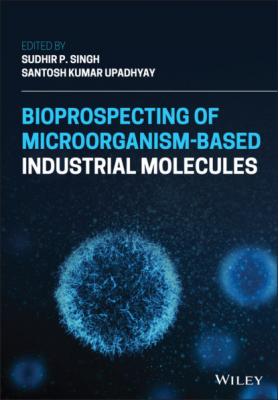Bioprospecting of Microorganism-Based Industrial Molecules. Группа авторов
Читать онлайн.| Название | Bioprospecting of Microorganism-Based Industrial Molecules |
|---|---|
| Автор произведения | Группа авторов |
| Жанр | Биология |
| Серия | |
| Издательство | Биология |
| Год выпуска | 0 |
| isbn | 9781119717263 |
| Microbial gum | Microorganism | Monosaccharides present | Linkages present | References |
|---|---|---|---|---|
| Xanthan gum | Xanthomonas campestris | Glucose, mannose, and glucoronic acid (2:2:1) | β‐(1,4), β‐(1,2), and α‐(1,3) | [14] |
| Gellan gum | Sphingomonas elodea, Sphingomonas paucimobilis ATCC 31461 | D‐glucose, D‐glucoronic acid, and l‐rhamnose (2:1:1) | β‐(1,3), β‐(1,4), and α‐(1,4) | [20] |
| Welan gum | Sphingomonas spp ATCC 31555 | L‐mannose, L‐rhamnose, D‐glucose, and D‐glucuronic acid (1.0:4.5:3.1:2.3) | β‐(1,3), β‐(1,4), and α‐(1,4) | [3] |
| Rhamsan gum | Sphingomonas spp. RH‐1 | D‐glucose, D‐glucoronic acid and L‐rhamnose | β‐(1,3), β‐(1,4), β‐(1,6), and α‐(1,4) | [21] |
| Diutan gum | Sphingomonas sp. ATCC 53159 | D‐glucose, D‐glucoronic acid, and L‐rhamnose | β‐(1,3), β‐(1,4), and α‐(1,4) | [22] |
| Pullulan | Aureobasidium pullulans Eurotium chevalieri, Cryphonectria parasitica, Cyttaria darwinii, and yeast Rhodotorula baracum | D‐glucose | α‐(1,6) and α‐(1,4) | [5, 23] |
| Scleroglucan | Sclerotium glucanicum | D‐glucose | β‐(1,3) and β‐(1,6) | [24] |
| Curdlan | Alcaligenes faecalis | D‐glucose | β‐(1,3) and β‐(1,6) | [6] |
| Levan | Bacillus subtilis, Bacillus polymyxa, Aerobacter levanicum, Leuconostoc mesenteroides, Streptococcus sp., Pseudomonas sp., and Corynebacterium laevaniformans. | D‐fructose | β‐(2,6) and β‐(2,1) | [12] |
| Dextran | Various LAB genera‐like Leuconostoc, Lactobacillus, Streptococcus, Pediococcus, and Weissella | D‐glucose | α‐(1,6), α‐(1,2), α‐(1,3) and α‐(1,4) | [25, 26] |
3.5.1 Xanthan Gum
Xanthan is a microbial gum produced by Xanthomonas campestris, a plant pathogenic bacteria. The molecular weight of xanthan, in general, can be 2000 kDa, but can also reach a higher weight of up to 50 000 kDa. Xanthan is a HePS and is composed of three different monosaccharides: glucose, mannose, and glucoronic acid in the molar ratio of 2:2:1 along with O‐acetyl and pyruvate groups [14]. Xanthan gum is resistant to degradation by enzymes and is highly pseudoplastic in nature, and it can maintain its viscosity over a wide range of temperatures and pH. In the presence of high shear stress, the xanthan gum viscosity is reduced but is recovered immediately upon the removal of the stress. This phenomenon occurs in xanthan due to the formation of intermolecular aggregates and polymer entanglement when mixed with water [27].
Xanthan gum is a highly efficient food hydrocolloid, emulsifier, and stabilizer, which is commonly used in the food industry. It is nontoxic in nature and is used as a natural food additive. The United States Food and Drug Administration (FDA) and European Economic Community have approved the use of xanthan gum as a safe food additive in 1984 and 1980, respectively [28]. After the approval of xanthan gum from X. campestris as a food additive, the demand for it has seen a steady rise at a rate of 5–10% annually [11]. In many scenarios, xanthan gum is mixed with plant‐based gum, guar gum, to obtain solutions of even higher viscosity than that from either one gum when used alone [29]. Xanthan gum has been reported to act as a prebiotic for dairy‐based lactic acid bacteria by improving bacterial viability under low pH, refrigeration, and the presence of bile salts [30]. Xanthan gum acts as a low‐calorie food hydrocolloid, as well as a fat replacer in various fat‐rich foods such as salad dressing, mayonnaise, ice creams, and cakes. The mixture of xanthan gum and guar gum had been reported to improve the crip and porous characteristics of deep‐fried foods when they were incorporated into the batter mix [29].
3.5.2 Sphingans
Sphingans are a group of EPS produced by Sphingomonas spp. They are of different types, namely, gellan gum produced by Sphingomonas elodea, welan gum produced by Sphingomonas spp. ATCC 31555, diutan gum produced by Sphingomonas sp. ATCC 53159, and rhamsan gum produced by Sphingomonas sp. RH‐1. All these EPS are structurally similar with identical backbone, but differ in the presence of side chain locations (Figure 3.2) [3].
3.5.2.1 Gellan Gum
Gellan gum is produced by Sphingomonas elodea and Sphingomonas paucimobilis ATCC 31461 under submerged fermentation using glucose as carbon source with a 40–50% yield [31]. Gellan gum is an anionic HePS, which is composed of d‐glucose, d‐glucoronic acid, and l‐rhamnose in a molar ratio of 2:1:1, along with side chains of O‐linked acyl, acetyl, and glyceryl groups [20]. The presence of acyl groups in gellan gum affects the rheology of the gel formed, resulting in soft, elastic, and thermos‐reversible gels. Chemical deacylation of gellan gum results in a more hard, brittle, and optically clear gels; this process generally used to produce industrial gellan gums (Gelrite or Kelcogel) [31]. Gellan gum generally has a molecular weight of 500 kDa and has the ability to form 3D network in the presence of monovalent or divalent cations such as Ca2+ or Na1+. Gellan gum is used for its gelling properties in food products like dairy, jellies, and confectionery products as a hydrocolloid and can be used to prepare edible films [2]. It has even been approved as a safe food additive by US and EU authorities for their use in food products as a gelling, suspending, and stabilizing agent, either alone or in combination with other food hydrocolloids [31]. Gellan has good compatibility with other gums or biopolymers such as xanthan or locust bean gum. Gellan, when combined with starch, improves the gas and moisture retention in a food product, which results in the reduction of starch used and enhancement in the flavor. Gellan gum is used to form gels in a concentration of 0.04–0.05% (w/v), which is very low compared to other gums [20].
